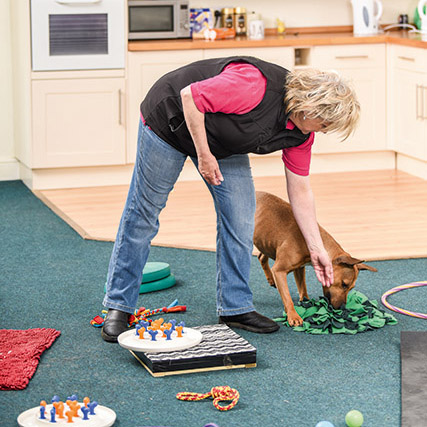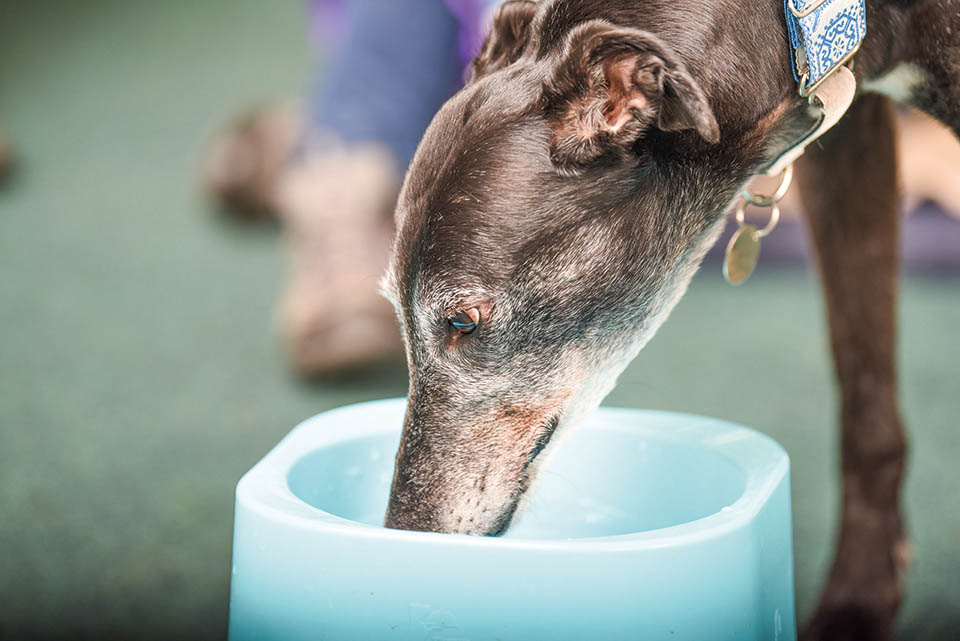Would you like to understand your dog better, and open up a whole new world of communication between you? Well, you can with Free Work. Behaviourist Sarah Fisher explains how.
If only they could talk’ must be one of the most overused phrases about our pets. But just because dogs don’t use human verbal language doesn’t mean they can’t — and don’t — communicate. They’re actually pretty good at it, but we aren’t always as good at understanding what they’re trying to tell us.
By using Free Work, you can open a window into your dog’s mind and create the possibility for two-way exchanges that will help with problem solving and training, and expand and enhance your relationship.
What is Free Work?
ACE (Animal Centred Education) Free Work encourages dogs to engage with a variety of items at liberty. A simple, low-impact activity, it’s suitable for dogs of all breeds and ages, and can be set up in any environment, indoors or out. Many professional trainers and behaviourists use Free Work, but it’s something that any dog guardian can try, and it’s a great way of helping you to understand your pet better and develop clearer communication between you both.
What are the benefits?
Despite being a low-impact activity, Free Work can work every single muscle and engage all seven senses — something that doesn’t necessarily happen on a walk! But it’s much more than a hands-free workout and enrichment exercise; it has a wide range of benefits for both you and your dog.
It provides you with a perfect way of observing your dog. Even when your dog is loose out on a walk, you’re not necessarily getting a true picture or detailed information. As well as highlighting body tension and mobility issues that may warrant further veterinary investigation, Free Work helps build confidence, develops relationships at a pace to suit your dog, and can be a terrific bonding exercise between you. It can also provide a foundation for learning important life skills, such as recall, settle, adapting to new environments, remaining relaxed in the company of other animals and people, and is a wonderful way of helping your dog to decompress after any events that may have caused him to be reactive or anxious.
Getting started with Free Work
Set up the environment
Do this before your dog enters the area you are planning to work in. If it has a slippery floor, such as laminate, wood, or tiles, ensure it is well covered with non-slip mats. You might be surprised how much water your dog wants to drink, even if he has access to it at all times in other areas of your home, so place at least one, preferably two, water bowls in the Free Work area. If possible, raise one of the bowls, and position both of them away from walls; this ensures your dog can continue to see around him as he sips, something which may be very important for anxious dogs.
Allow your dog to investigate everything at his own pace.
Set up the objects
Lay out some different surfaces, such as rubber matting, carpet squares, yoga mats, towelling mats, cardboard, and even door mats. Include some upturned low-level boxes or upturned dog bowls, plus some treat-seeking mats (such as snufflemats and food foragers) both on the floor and on some folded towels, or on a plastic tub to raise their height. As well as surfaces with different textures, set out a few objects that make noises, such as beanbags and ball pools. Don’t place everything too far apart, as your dog may then trot between them, which isn’t what you want.
Put a variety of different treats in the treat-seeking mats and on the surfaces; scatter a little food around on the floor too, so that your dog always has easy access to treats and doesn’t have to make contact with anything he might find worrying in order to get the food. Also, place some toys within the Free Work area so that he can interact with a toy on his own as part of this activity.

Lay out lots of different objects to engage all the senses.
The aim is to give your dog opportunities to engage with a variety of different items, enabling you to spot those he really enjoys interacting with, and those he actively avoids. Give plenty of choices: there’s no maximum number, but it depends on how much space you have. Ideally provide a minimum of six objects, but if you only have a small area then as few as three is fine.
Treats
As well as the usual training-type treats, put a little paste, squeezy cheese, or mashed wet food on those items that are easy to clean to encourage your dog to use his tongue. Include a few larger treats too; crunching these at the back of the jaw can help your dog to decompress, and can also provide him (and you) with valuable processing time.
Avoid using too many treats in one go, and remember to decrease the amount of food in your dog’s meals accordingly, as it’s important not to over-feed for health reasons.
If your dog has known issues around food and can guard food items (or items that carry the scent of food) avoid using treats and provide lots of different smells instead, such as bedding from small animals, hay, straw, leaves, and grass.
Scents do not have to be super strong, and you can get really creative with them. Place the different scents inside old pillow cases or small hessian sacks (used to make sand bags in times of flooding) and tie them securely to keep the contents inside; this will protect your dog in case he tries to eat the non-food items as well as limiting the amount of clearing up you have to do.
Make sure water is available — place at least one, and preferably two, bowls in the Free Work area.
Changing the set-up
Change the set-up between sessions; move items around as well as adding new objects, textures, treats, and activities at a pace to suit your dog to give him new experiences and help you hone your dog detective skills.
Introducing Free Work
Bring your dog into the Free Work area. If it’s safe to do so, remove all equipment including his collar and let him explore at his own pace; don’t encourage him to investigate the items unless he’s unsure about what to do. This in itself can be a useful part of the observations you might make (see the checklist right).
If your dog can’t be at liberty for any reason, starting Free Work with him on a long, light line can still be a rewarding and illuminating activity for both of you. Ensure you follow him, and keep changing your position so you don’t block his movement or create tension on the line.
Reload the items with treats if your dog is enjoying the Free Work; if he follows you around hoovering them up as you do so, scatter some treats in a treat-seeking mat to keep him engaged while you get on with placing more food on the other items.
Spend around 20 – 30 minutes on each Free Work session, less if your dog starts to become over-stimulated, although this is rare!
● If you share your life with more than one dog, work with each of them individually to avoid competition over potentially exciting resources.
Allow your dog to investigate everything at his own pace.
Observations
A few simple guidelines on things to look for:
● Note the speed at which your dog enters the area and moves around the Free Work items.
● Does he ‘speed read’ and only grab some, but not all, of the treats?
● How long does it take before he slows down and investigates the items more thoroughly? Or how long does it take for him to engage if he is a little hesitant at first?
● Which items does he enjoy and return to, and which does he actively avoid?
● Does he always move in the same direction around the area or does he move both anti-clockwise and clockwise?
● How long does he remain engaged with the Free Work items?
● When and how does he take a drink? Does he take a long drink as he starts to relax, or multiple quick laps of water, which can be a sign of increasing arousal or anxiety?
● Pay attention to the position of your dog’s tail and ears, and note the movement (or lack of it) through his back.
● When licking some paste, does he stand in balance, or position one or more legs forward, back, or out to the side?
● When eating or licking the treats, does he tilt or bend his neck and head only one way?
● Listen to footfall, respiration, and scenting, and note when this might change.
If you aren’t sure what signs to look for in terms of your dog’s movement and behaviour (or how to interpret them), video the sessions and share that video in our friendly group for more support; you can also contact an ACE tutor or trainer.










